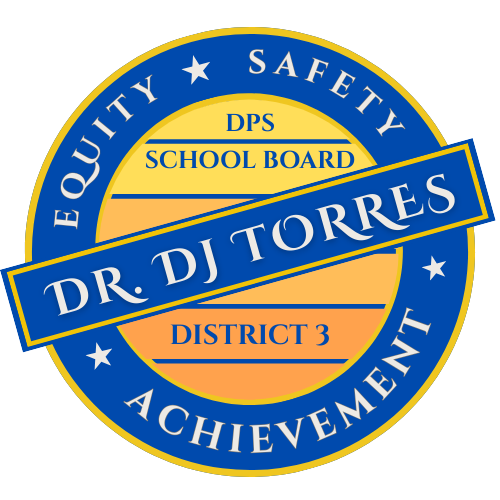
My Commitments
In order to improve…
-
1. Expand Mental Health and Wellness Supports
Advocate for increased school-based mental health professionals, invest in peer leadership programs, and partner with community organizations to bring wraparound services into our schools.2. Advance Trauma-Informed and Inclusive Practices
Ensure every educator and staff member is trained in trauma-informed, culturally responsive approaches that prioritize connection, care, and accountability over punishment.3. Build Belonging Through Youth and Family Voice
Support student-led initiatives like restorative justice circles and mentoring programs, and create regular feedback loops that include families and caregivers in decision-making.4. Promote Safe and Supportive Learning Environments
Use data to monitor school climate and safety—disaggregated by race, disability, and more—and take action to ensure every school is a safe, welcoming place for all students.5. Strengthen Oversight of District Leadership
Set and review clear expectations for the superintendent rooted in equity, safety, and student success—ensuring transparency, community accountability, and measurable progress. -
1. Ensure Equitable School Funding
Push for a budget that prioritizes schools with the highest needs—ensuring resources, staffing, and supports are distributed based on equity, not equality.2. Reduce Class Sizes Where It Matters Most
Advocate for targeted class size reductions in early grades and high-need schools to support deeper learning, stronger relationships, and individualized instruction.3. Expand Access to Rigorous, Inclusive Learning
Ensure every student—especially students of color, English learners, and students with disabilities—has access to advanced coursework, arts, STEM, and culturally relevant curriculum.4. Improve Access to College and Career Pathways
Strengthen programming that prepares students for life after high school, including inclusive college advising, career-connected learning, and credentialing opportunities.5. Partner with the Superintendent to Advance Equity
Work closely with the superintendent to align district-wide priorities, budgets, and staffing decisions with clear equity goals—ensuring transparency, accountability, and measurable results. -
1. Advocate for Competitive, Equitable Pay for Educators
Support compensation structures that recognize the expertise of teachers, prioritize high-need schools, and help retain experienced educators across the district.2. Protect and Grow School-Based Staffing
Fight to keep funding in classrooms—not just central office—by prioritizing investments in teachers, counselors, support staff, and paraprofessionals.3. Improve Budget Transparency and Community Input
Ensure families, educators, and community members understand how dollars are allocated and have a real voice in district budgeting decisions.4. Stabilize Funding for Long-Term Planning
Push for multi-year budgeting and sustainable financial planning that allows schools to plan ahead and reduce disruptive staffing changes year to year.5. Collaborate with the Superintendent on Fiscal Equity and Stability
Partner with the superintendent to ensure the district’s financial strategy supports both long-term sustainability and fair compensation, with clear accountability to schools and stakeholders. -
1. Protect the Rights and Safety of All Students
Ensure DPS remains a safe, welcoming, and non-punitive environment for immigrant, refugee, and undocumented students and families—free from fear or discrimination.2. Expand Language Access and Interpretation Services
Strengthen interpretation, translation, and multilingual communication so families can meaningfully engage in their children’s education and school community.3. Increase Culturally Responsive Support Services
Advocate for more counselors, social workers, and family liaisons with cultural and linguistic expertise to support students navigating trauma, housing insecurity, or resettlement.4. Build Stronger School-Community Partnerships
Work with trusted community-based organizations to bring legal, health, housing, and other wraparound supports into schools serving vulnerable student populations.5. Partner with the Superintendent to Prioritize Inclusive Practices
Collaborate with the superintendent to ensure immigrant and refugee students are centered in district planning, staffing, and resource allocation—with clear public reporting and accountability. -
1. Prioritize Stability and Transparency
Oppose unnecessary school closures and consolidations that disrupt learning and destabilize communities—especially in neighborhoods already impacted by underinvestment.2. Build Participatory Practices with Communities
Ensure families, educators, and students have a meaningful role in shaping decisions about school changes—through accessible meetings, multilingual outreach, and shared decision-making processes.3. Strengthen Criteria for School Viability
Push for holistic measures of school success that go beyond enrollment and test scores, including school climate, community value, and growth over time.4. Invest in Under-Enrolled Schools, Not Just Consolidation
Support creative strategies like co-location, magnet programs, and wraparound services to revitalize schools before resorting to closure or merger.5. Work with the Superintendent to Ensure Equity in Planning
Collaborate with the superintendent to center equity and transparency in all long-term planning—ensuring school changes are data-informed, community-led, and prevent harm to vulnerable populations.

